#pet mink are absolutely unethical
Text
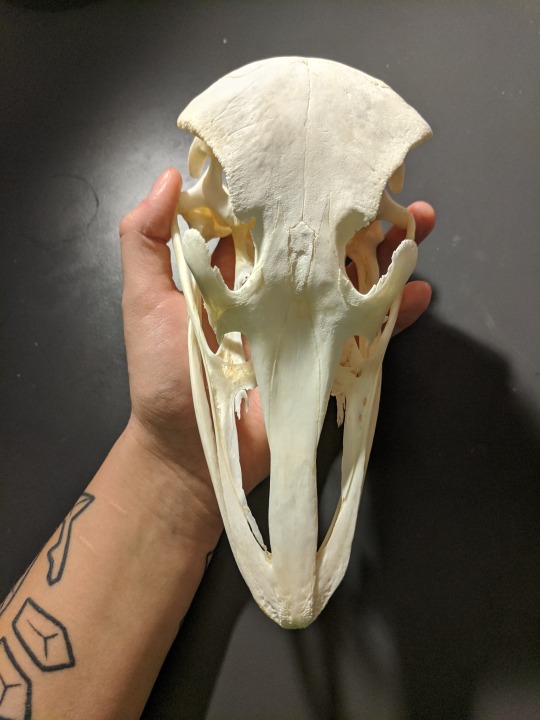
this is my ostrich skull. it's a young adult specimen, and I love it to bits! it is, however, a Chinese sourced skull. I didn't know - I had bought it second hand from an antique shop, and it didn't occur to me ostriches were the new thing!
we've been told for a while now never to buy Chinese skulls - they're often poorly cleaned (this boy here has got some grease, and foxes can be orange with it), and come from fur farms, which are rife with abuse and neglect.....right?
we all want to avoid supporting unethical trades in the Vulture Culture Community, and I'm absolutely all for that. avoid those fruit bats, as they're hunted en masse for their parts. avoid that certain Indonesian eBay seller, and all those African facebook sellers who found 50 perfect dead hornbills. however, on the basis on Chinese fur farms having high levels of animal abuse? the only examples I've seen can be traced back to animal r/ghts activism or radical v*gan (censored so this doesn't pop up in the searches) articles - which have either been exposed as faked, or are notorious for taking what they record out of context, for example, filming a cow bellowing "desperately for its baby," when in reality, she's just in heat.
china is, indeed, infamous for its poor welfare standards and regulations. but I've been thinking, and I've found it hard to believe just because the welfare standards are lower, every single ostrich farm and fox ranch out there are treating their animals horribly. a neglected, uncomfortable ostrich will not produce enough eggs, and it's more economic to meet its needs. a cramped, stressed fox will have poor quality fur.
one example on an article by natgeo shows a photo of a mink fur farm owned by a small business. it shows the enclosures appearing to be quite small, with even smaller, mobile cages containing a mink in each on top, and two staff members. those mobile cages are almost definitely to temporarily contain the animal, possibly during enclosure upkeep. and yes, the enclosures are small - but consider how poultry is raised. often in worse conditions, bred to crush themselves under their weight if not culled, beaks clipped so they can't kill eachother. this is acceptable by our welfare standards, and the same people (including myself!) who have been warning against the ethicality of Chinese specimens, have been happily devouring some KFC.
at this point, it appears arguements against these sources have turned from a worry for ethics, to borderline stereotyping and racism. I've caught some folk saying some nasty stuff following a conversation about Chinese specimens. when in reality, I haven't seen any refutable source to support the notion that, currently, a large enough portion of farming in China is abusive enough to warrant warnings of maltreatment to animals over byproducts on ebay.
this isn't to say go on eBay and buy 15 greasy fox skulls right now because it's actually okay! I haven't found any sources of the contrary, either, which isn't surprising - positive articles about any kind of farming are few and far between as fearmongering over the finnish furfarm and PET@ takes hold of western media, and because, well, farms SHOULDNT be praised with media attention for treating animals well, it's a bare minimum. I'm asking for a discussion - is it as bad as we make it out to be? are the poor practices held by a majority, or only a viral minority?
I would absolutely love any takes and sources on either side of this. I would love to believe things have been exaggerated, but I know i may just be feeling hopeful, too. please note I am not v*gan, never have been, never will, I'm a huge supporter of sustainable farming and hunting for any resource, I believe fur farming should not be banned, please do not dump animal r/ghts stuff on this post.
#nvmr.txt#ask to tag#just doin some thinking.#ive seen a lot of folk being okay with livestock skulls but having a problem with mink or fox#on the basis that theure specifically farmed for fur.#which is really weird? like REALLY weird.#alpacas are only kept for wool. goats are only kept for milk. animals only kept for one specific thing is fine#farming for fur isnt inherently more cruel than farming for meat. besides#like. mink and fox meat become pet food a lot o believe! and theres no reason why we cant adjust their diet and do some more-#selective breeding to make their meat more appealing as human consumption tppt.
24 notes
·
View notes
Text
All About Cute Breed Bengal Cats

All About Cute Breed Bengal Cats
Back in the 1980's Jean Mill (Millwood Bengals (USA) thought how wonderful it would be to have a domestic size cat with the exotic look and markings of a Leopard!
Jean acquired an Asian Leopard Cat (Felis Bengalensis) which is a small,forest-dwelling wild cat that inhabits parts of Asia. Its markings are similar to that of the Leopard.
The next step was the mating of the Asian Leopard Cat to the American Shorthair and domestic cat she used these cats to stabilize the timid, shy temperament of the Asian Leopard Cat.
After years of frustration and excitement, the Bengal cat as we know it today emerged.
Modern Day Bengals
The Bengals of today are truly a breed that intrigue and delight almost everyone who comes in contact with them. Their beautiful patterns, colors, and markings along with their inquisitive nature make them a unique breed to own.
Colors and Markings
Bengals come with varying background coat colors, cream, golden and orange, on these base color's they can have either 'spotting' or the exotic 'marbling' pattern.
'Rosettes' highly sort after as this particular pattern most resembles the markings of the Asian Leopard Cat and the Leopard (see photo on the right)
Snow Coloured Bengal's
Bengal's also come in what is called 'snow' coloring and have the same markings and patterns as the traditional 'brown or marbled' Bengal's. The 'snow's' come in three different categories which are as follows:-
Seal Lynx Snow
Seal Mink Snow
Seal Sepia Snow
Warpaint litter Bengal Temperament
Bengal's are boisterous, energetic and very playful, sometimes a little headstrong and quite often naughty!!!
They are very intelligent and can be quite easily taught basic commands. Many walk on a leash and come when called, they love to retrieve paper or balls. They really are more dog like that cat!
I am sure they know what you are going to do before you do it!
I hope this introduction will encourage you in your final decision into owning one of these wonderful animals. I can almost guarantee you will not regret it!
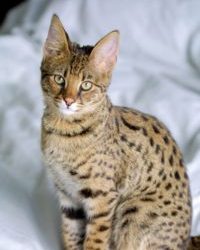
bengal cats pets
Bengal Cats are not wild contrary to many people's opinion. They were bred from the crosses of the Asian Leopard and domestic cats. And, now they are extremely popular since they make good pets and have a beautiful leopard-like coat. The breed is said to be more domestic than wild, yet it has retained some of the habits peculiar for a wild animal such as climbing trees. Nowadays, almost all major organizations recognize the breed and it is eligible for showing.
Bengal Cats - Description
These are large cats that can reach a size of 15 pounds. Females are usually smaller than males with the average weight being 8-10 pounds. They are robust rather than delicate and have a well-developed muscle structure. The legs should be slightly longer in the back than in the front. The feet are large and rounded. A broadhead that may seem slightly small in proportion to the body characterizes the breed. The muzzle is broad and has prominent whiskers with high cheekbones.
Bengal Cats Coat The Bengal cat has a very soft short to medium coat that is slightly longer in kittens. It is thick and luxurious and comes in various color patterns. Some Bengal cats may have a traditionally dark background color with stripes and spots. Others are called snows since the background color is creamy or pale white. It is desirable for Bengal Cats to have glitter.
Bengal Cats - Breeders - Rescues
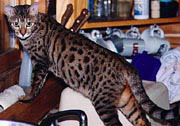
Those Bengal cats that have at least three to four Bengal-to-Bengal breedings in their background are considered as the best pets. An SBT (stud book tradition) Bengal cat has four or more generations of Bengal-to-Bengal breedings. F1 Bengal cat comes from a breeding of a Bengal cat and the Asian Leopard, so F2 Bengal cats come from Bengal-to-Bengal breeding with one Bengal-to-Asian Leopard Cat breeding, etc. Once, the Bengal cat could be bred to cats with similar color pattern, yet this practice seems to be gradually reduced. Nowadays, most catteries breed Bengals to Bengals and are proud of their pets. The price of a Bengal cat varies from $650 to $800 and can reach as much as $2000. Needless to say, pet quality Bengal cats are comparatively less costly than show quality Bengal cats.
Those Bengal cats that have at least three to four Bengal-to-Bengal breedings in their background are considered as the best pets. An SBT (stud book tradition) Bengal cat has four or more generations of Bengal-to-Bengal breedings. F1 Bengal cat comes from a breeding of a Bengal cat and the Asian Leopard, so F2 Bengal cats come from Bengal-to-Bengal breeding with one Bengal-to-Asian Leopard Cat breeding, etc.
Once, the Bengal cat could be bred to cats with similar color pattern, yet this practice seems to be gradually reduced. Nowadays, most catteries breed Bengals to Bengals and are proud of their pets. Needless to say, pet quality Bengal cats are comparatively less costly than show quality Bengal cats.
TICA (The International Cat Association) registers Bengal Cats, so do most other registries except the CFA (Cat Fancier's Association). For more information about standards and registries contact the AACE (American Association of Cat Enthusiasts), ACF (Australian Cat Federation), ACFA (American Cat Fanciers Association), TICA, or UFO (United Feline Organization). Various organizations dedicated solely to Bengal Cats can also provide information about the breed and breeding issues.
(adsbygoogle = window.adsbygoogle || ).push({});
Bengal Cat Breeders
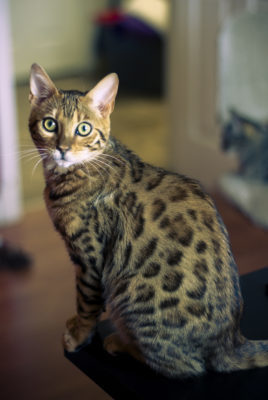
bengal cats pets
Of all Bengal Cat Breeders, Jean Mill is definitely the most recognized and famous one, since it was her who created this unique breed, and to who the whole world owes the pleasure of contemplating these sweet little leopard cats. Bengal Cats look very similar to Wild Asian Leopards, as they carry their gene, but they are not wild by nature and are as good with humans as any other domestic cat.
Bengal Cats enjoy home life, and they cannot imagine it without interaction with their loved ones. They are very strong and enduring cats and are quick to learn new things and tricks. Bengal Cats enjoy splashing about in water and are famous for the vocal characteristics that single them out from all other domestic cats. Besides their melodic meowing, they can give all sorts of trills, twitters, chirps and so on. They seem to have a much richer vocal language than most other domestic cats, although they are not extremely noisy. Bengal Cat Breeders can tell you all you want to know about the cat’s temperament so that you will see if this is the right cat for you.
Many people have a biased attitude toward these cats because of their wild appearance and for fear of aggression. All purebred Bengal Cats of today are completely free from wild behaviors, being even more people-oriented than some most intelligent Oriental cat breeds. Bengal Cats are superb pets, and they never show unmotivated aggression. They enjoy being carried in the arms, and are good with strangers. Show cats are known to withstand over 100 handlings each day without a single growl or bite. If you would like to have a “miniature leopard” in your home but still have doubts about his temperament, it is high time for you to turn to an experienced and qualified Bengal Cat Breeder who will dispel all myths and misconceptions about this wonderful breed.
Bengal Cats have a flexible and sturdy body formation. Their coat comes in spotted or marble patterns. There are quite many coat color patterns common to the Bengal Cat, and there are no two identical cats on the planet. However, all Bengal Cats bear a strong resemblance to the Wild Asian Leopard, as this is the reason why they were bred. Bengal Cats are the only felines whose coat has a unique pearl or gold dust sheen and notably soft texture. Bengal Cats are large domestic felines, weighing up to 20 lbs. These cats are capable of expressing their emotions in numerous fashions and can be either rambunctious or peaceful, depending on their mood. Bengal Cat Breeders take great care selling their cats to responsible and trustworthy people, who will not engage in unethical breeding or take to abusive or harsh handling.
Domestic Bengal Cat
The Domestic Bengal Cat is a unique breed of cats, which is not yet recognized by the Cat Fanciers’ Association (CFA), but it has a registry with the International Cat Association (TICA). Actually, the Bengal Cat is a hybrid cat that was created by crossing the wild Asian Leopard with a number of domestic breeds with the goat to create a “miniature” leopard with what can be termed as “absolutely domestic temperament”. Indeed, Bengal Cats, though they look definitely wild, are absolutely people oriented and show no more aggression than any other domestic feline.
Domestic Bengal Cats possess a characteristic leopard-like appearance and are strongly reminiscent of their wild ancestors. They are sturdy and athletic, with hind-quarters a little higher than the front, and with a characteristic thick striped tail. The coat is spotted or marbled, and there are a number of coat patterns typical of the breed: Seal Marbled Lynx Point, Seal Mink Marbled Tabby, Seal Mink Spotted Tabby, and Seal Spotted Lynx Point, and so forth. The coat is very smooth and feels silky to the touch, and it has a unique pearl or gold dusting glitter. Bengal Cats have dark stripes extending from their eyes and going to the back of the neck.
The Domestic Bengal Cat is a very intelligent and communicative feline. He is absolutely free of any unprovoked aggression and will love to keep you company in whatever job you are going to do. Bengal Cats are renowned for their sweet and loving temperament, as they have scores of ways of expressing their emotions. They seem to completely understand human language and can be trained to do a number of tricks. Many Bengal cats learn easily to open doors, turn on and off water taps, switch on and off a light, etc. They are particularly inquisitive about food. The Bengal Cat is one of the few felines that love water. The Bengal Cat is famous for his loud and melodic voice, as well as for a number of other unique, almost bird-like twittering and chirping sounds he can produce.
Bengal Cats are not widely spread, and hence they are highly prized. If you feel like having one in possession, you must be ready to pay a large sum of money for a kitten. It is absolutely imperative that you purchase only from a reputable breeder and strictly follow his or her advice on how to properly care for this cat. The Domestic Bengal Cat is a very friendly and affectionate companion, but you must make sure all cats are well socialized and enjoy good care.
(adsbygoogle = window.adsbygoogle || ).push({});
Bengal House Cat
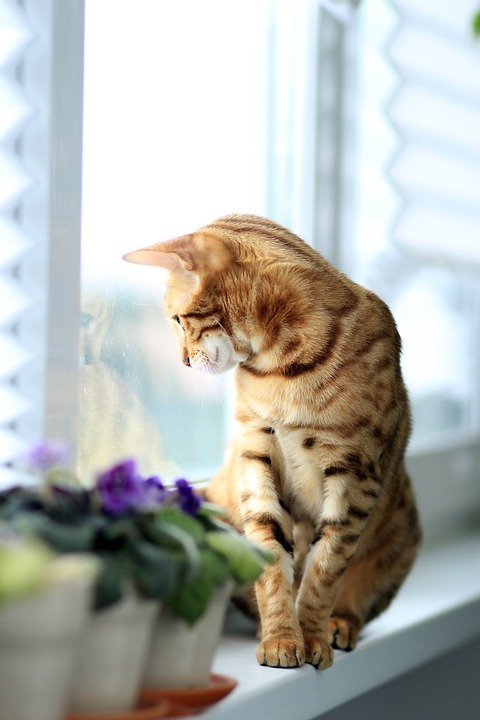
Bengal cats
The Bengal House Cat is a great pet, as he is not too demanding in terms of daily care. However, this is quite a rare and expensive breed of cats. The breed originated in the 1970s, by Jean Mill, who strove to develop a unique feline species with the size and temperament of a usual domestic cat and with the appearance of a leopard. In other words, the Bengal cat resulted from the addition of the gene of the Wild Asian Leopard to the domestic cat’s genetic pool.
The Bengal cat was accepted as a breed in 1983 by the International Cat Association (TICA). However, the Cat Fanciers Association of the USA rejected the breed as most American organizations tend to be more suspicious about hybrid species. Today, there seem to be few reasons to fear behavioral problems in the Bengal Cats allegedly stemming from the Leopard’s gene, as these cats are more people-oriented and better lap companions than many old and reputed domestic cat breeds. Bengal House Cats of today are not sterile and are bred successfully. First crossings did produce sterile males, but Jean solved this problem by diversifying the animal’s genetic makeup. There are no sterile species in four-generation Bengal Cats.
This wonderful breed attracts the attention of cat lovers all over the world by its exotic feline appearance. Their coat features characteristic jaguar-like patterns of rosette-shaped spots on the back and sides. There are distinctive dark lines extending from the eyes and then go backward. Bengal House Cats are large in size, weighing 10-20 lbs; males are larger than females. Bengal Cats come in spotted and marbled colors, which include the following: Seal Spotted Lynx Point and Seal Marbled Lynx Point, Seal Sepia Spotted Tabby and Seal Sepia Marbled Tabby, Seal Mink Spotted Tabby, Brown Spotted Tabby, Brown Marbled Tabby, and Seal Mink Marbled Tabby.
Bengal Cats are increasingly popular in various parts of the world. With so many people showing interest in this breed, Bengal breeders and experts have realized the importance of preserving the purity of the cat’s gene pool. For this reason, responsible and reputable breeders tend to scrupulously check potential buyer’s personal qualities and opportunities in order to make sure they can handle them properly and keep them sound and healthy. Every buyer, in turn, must purchase kittens only from reputable breeders, who produce purebred kittens and breed for quality, not quantity. Purchasing from a responsible breeder will guarantee you a happy and funny life with your Bengal House Cat for years to come.
Bengal Cats - Temperament and Habits
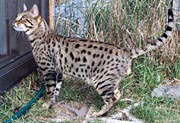
Bengal cats are said to make good pets as they are beautiful and spend much time with their owners. They like to play and often use their claws as hands. Supply them with a toy and see how they will catch and fetch it to you. However, they have retained some of the instincts peculiar for wild cats. They are good tree climbers, so supplying them with a tree is essential.
They enjoy the water, which is not peculiar for most felines. Isn't this fact amazing? In fact, they will immediately start playing with water once the owners leave the shower on. Intelligent and playful, they make good companions for children and are generally good with other cats and dogs.
Temperament depends much on the background of the Bengal cat. The greater the percentage of Asiatic Leopard blood, the wilder the pet cat is. It is recommended to buy Bengal cats that are removed at least three or four generations from the Asiatic Leopard. Otherwise, they can be hard to manage.
Bengal cats make great show cats on the condition that they are well mannered. The standard accepts such behavior as restlessness and anxiety during a show. Yet, Bengal Cats that resist any examination and are unruly during a show should be disqualified.
https://www.youtube.com/watch?v=hL44i4o3-gM
(adsbygoogle = window.adsbygoogle || ).push({});
Follow us on : Facebook, Twitter, Instagram, Pinterest
Read the full article
#bengalcats#bengalcatsandwater#bengalcatsfighting#bengalcatsfunny#bengalcatsjumping#bengalcatsplayinginwater#bengalcatsswimming#cutecats#fatcat'snewyearsresolutiononeanimalsexerciseregimencat'sstrictweightlossdiet#health#overweightcatlosesweight#tinytimfatcat
0 notes